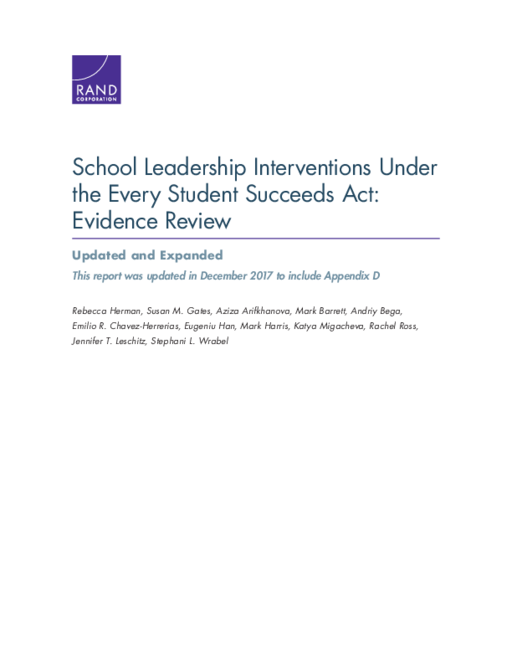Breadcrumb
- Wallace
- Reports
- School Leadership Interventions ...
School Leadership Interventions Under the Every Student Succeeds Act
Evidence Review, Updated and Expanded

- Author(s)
- Rebecca Herman and Susan M. Gates
- Publisher(s)
- RAND Corporation
- DOI Link
- https://doi.org/10.7249/RR1550-3
Summary
How we did this
The RAND Corporation synthesized evidence on school leadership efforts to determine the types of activities and interventions eligible for funding under the Every Student Succeeds Act.
The 2015 Every Student Succeeds Act (ESSA) recognizes that principals are essential to most school-improvement efforts. It offers states and districts significant funding possibilities to promote effective school leadership. It also requires evidence for the effectiveness of funded activities. This report helps states and districts understand how to demonstrate the effectiveness of proposed activities when applying for ESSA funding. This law is the federal government’s major source of dollars for public schools.
This RAND publication is an updated and expanded edition of a report originally released in April 2016. It describes:
- The opportunities under ESSA to support principals, other school leaders, and principal supervisors
- The law’s framework for evidence for use by policymakers and educators. These describe evidence in four “tiers” of rigor. Tier I evidence has the most stringent research base and is considered the most rigorous. Tier IV is the least rigorous.
- Six categories of leadership-focused activities consistent with the evidence provisions of the law. They are:
- Leader-evaluation system
- Principal preparation program
- Strategic staff management
- Professional learning
- Working conditions
- School improvement models
- How states and districts can draw on evidence of effectiveness for branded programs by replicating the components of those programs.
- How states and districts can use research-based practices to support principals and other school leaders.
An accompanying commentary summarizes the report’s key points.
ESSA is the successor to the No Child Left Behind law. Its Title I section provides for a School Improvement Funds program. This program along with other parts of Title I can be tapped for school leadership efforts. ESSA also makes explicit that Title II “human-capital” management funding can be used to support principals, other school leaders, and principal supervisors.
In 2017, the publication was expanded to include an appendix describing key features of 17 evidence-based endeavors to strengthen school leadership. A companion guide explaining logic models necessary for Tier IV evidence was also published in 2017.
Key Takeaways
- The 2015 Every Student Succeeds Act (ESSA) offers states and districts significant funding possibilities to promote effective school leadership. Funding can be used to support principals, other school leaders, and principal supervisors.
- The federal law also includes new provisions requiring evidence for the effectiveness of funded activities. This report explains how to demonstrate the effectiveness of proposed activities when applying for federal funding under ESSA.
- The report describes six categories of activities aimed at improving leadership that can be funded under ESSA. They are: 1) leader-evaluation systems; 2) principal preparation programs; 3) strategic staff management; 4) professional learning; 5) working conditions; and 6) school improvement models.
- The report explains how states and districts can draw on evidence of effectiveness for branded programs by replicating the components of those programs.
Materials & Downloads
What We Don't Know
This publication does not answer all questions about which leadership activities would qualify as evidence-based. Users should refer to the U.S. Department of Education’s (2016c) Non-Regulatory Guidance: Using Evidence to Strengthen Education Investments as Evidence Guidance for clarification as needed. However, there remain some points of ambiguity.

